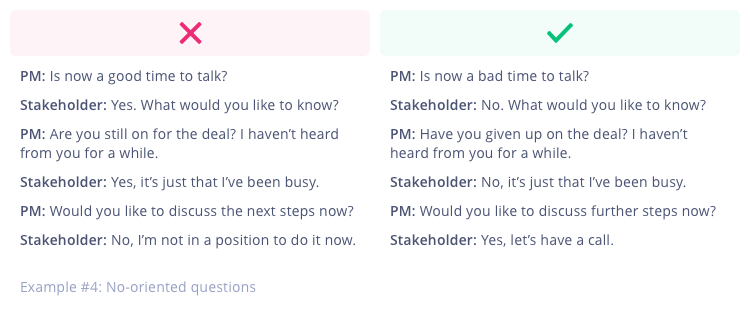Project management is an arena where negotiations are largely about making deals, resolving resource conflicts, and creating win-win outcomes. Whether you’re a project manager or a CEO, you should always seek ways to find middle ground and prevent friction. Put simply, you should be prepared for the storm. To help you master the art of negotiation, we’ve collected the most relevant tips and techniques for project managers and executives.
What Makes a Good Business Negotiator?
A good negotiator is a virtuoso of persuasion who can calculate all possible approaches to a situation and is prepared to instantly weigh the options and adapt the most suitable tactic. A good negotiator plays the role of interviewer in disguise, leading the conversation and asking more than answering. But pay attention: our experience shows that good negotiators never ask abstract questions. They know that being specific is how you gain control and get a better understanding of the situation.
Gordon Ryan, Senior Vice President of Operations at Eirtech Aviation Services Ltd., points out that the first step to a successful negotiation is preparation. He shares a few tips on how to equip yourself before making an offer:
Before any serious negotiation, you must analyze the players – how they look, how they dress, how far they’ve travelled, whether they have a flight booked to leave that day, how is their family, are they under pressure – the more information you have, the better. If there’s a team you’re negotiating with, work out the dynamics – Who’s actually going to make the decision? What’s their background? Does your proposal address their concerns?. The first step is to learn someone else’s position.
By learning someone else’s position, good negotiators can build successful strategies. In short, if you want to become a negotiation ninja, Ryan’s simple message is know the room. Identify the walls, the places where you can snug down, and the limitations of the space.
A good negotiator isn’t only an orator and thinker. He or she can persuade the public like Winston Churchill and win presidential debates.
Speech Negotiation Hacks
It might surprise you, but the key to negotiation is the language you use. The first rule to leading a successful conversation is to avoid questions that start with why. Why sounds accusatory in most any language and should be replaced with a more detailed and direct question word. Consider the following examples:

Questions that start with what tend to be more specific and goal-oriented. When you start a question with what, the customer is then responsible for supporting their argument with information that will be valuable for the project. This hack is a simple way to sidestep misunderstandings and get the most out of your conversations.
Read on: The Secret Behind Constructive Feedback Revealed
Chris Voss, the author of Never Split the Difference: Negotiating as if Your Life Depended on It is convinced that his experience of an FBI agent has taught him to disarm anyone and talk them into just about anything. Voss believes that expressing our emotions is the main enemy of negotiation. That’s why he puts forward five tested techniques that emotionally intelligent people use in situations that require persuasion.
1. Use mirroring. Voss’s advice is to repeat your counterpart’s last words in a “late night FM DJ voice,” asking a mirror question. This trick slows down the conversation so you have more time to think while your counterpart is revealing themselves. People love this hack because it’s simple and effective.

2. Show tactical empathy. Empathy can be expressed with phrases such as “it sounds like you’re afraid of” and “it looks like you’re concerned about.” By speaking your thoughts like this and demonstrating that you can empathize with the other party, you help keep them from worrying. According to Voss, “expressing—and not denying—accusations they may be harboring (no matter how ridiculous) keeps them from festering.”

3. Yield to “no.” Make your first and second questions ones that your counterpart will likely respond to with a “no.” Pushing people to say yes is a last-century technique that only strikes fear into your counterpart. By being able to say no, your counterpart doesn’t feel trapped and they assume they can control the situation. The following example of a conversation with a demotivated team member can help you understand this technique better:

4. Lead to “that’s right.” Once you’ve set up a framework for understanding the other party’s feelings, you can slip into the next trick by asking a question that elicits a “that’s right” reply. Voss calls this moment a “breakthrough in negotiation” because it’s when your counterpart begins to empathize with you. To trigger this response, you can sum up and reaffirm your counterpart’s feelings and state what they want. Take a look at example #3 once again with this in mind.
Read on: 13 Methods to Forecast, Analyze, and Solve Problems
5. Give the illusion of control. Voss says that it’s useless to force your opponent to admit that you’re right. It’s always better if your counterparty has the illusion of control. You can achieve this by asking how and what questions to encourage them to use mental energy in forming their replies. Look at example #3 once again to see how the two steps mentioned above work in tandem.
Chris Voss’s techniques are designed to create a win-win feeling for both parties but to make sure that you’re the true winner in the long run.
How to Resolve Resource Allocation Conflicts
But there are more conflicts in project management, especially when managing a multi-project environment with a few project managers in the county. Given that these project managers have to share the work hours of one team, they’re bound to fight for resources and the company is bound to become an area of conflict.
To prevent quarrels, project managers and their teams need access to priorities at the organizational level. They should be able to answer what the most important task is on the work floor and mobilize their forces. You can use Epicflow software to get a prioritized view of tasks that come from Jira or MS Project. By sharing the analytical data from Epicflow’s pipeline and tasks list to your fellow project manager, you’ll be able to convince them to find the best possible way to allocate resources. This might involve considering another person for a task, for instance. Over time, Epicflow can help dissolve conflicts.

